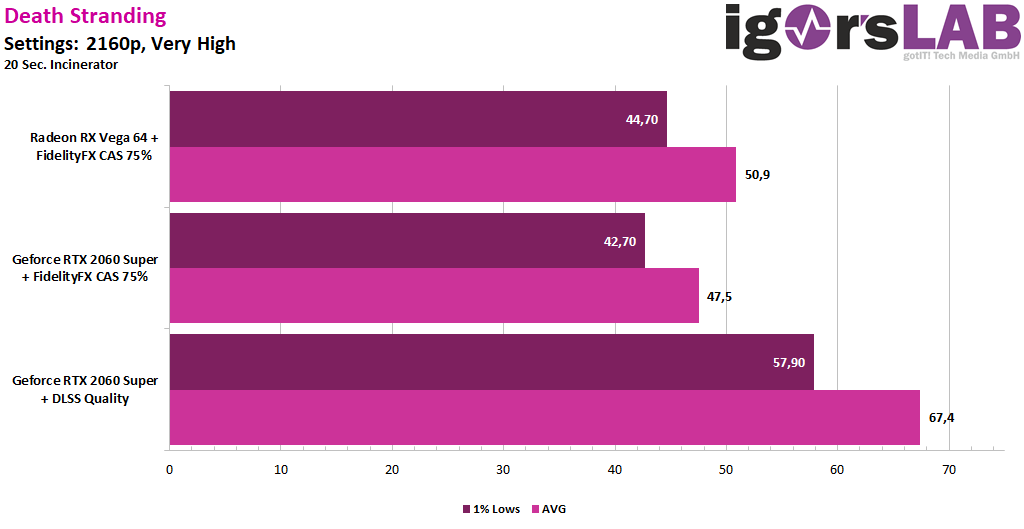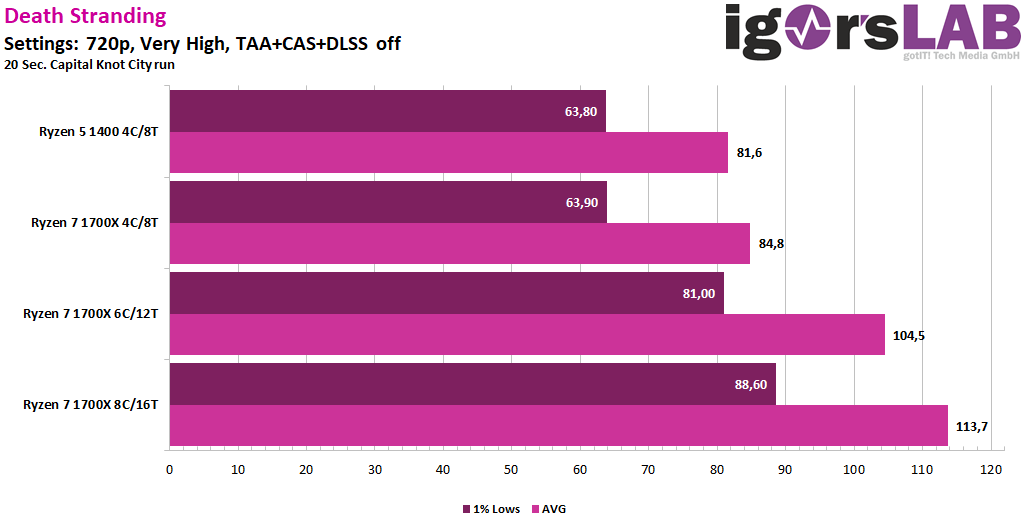Benchmarks
1080p Test
First I tortured the small budget PC with Death Stranding. On the positive side, you can even enjoy the game at 60 FPS with the 8 low clocking threads of the Ryzen 1400 and a 6 year old midrange GPU with minor limitations. The bottleneck of the GTX 970 seems to be the VRAM, because only by reducing the >Streaming memory, the VRAM can be used for the GTX 970 The RX 580 8GB didn’t have this problem and could display the game in this resolution in maximum details with 60 FPS.
1440p test
For 1440p, maximum details and more than 60 FPS, it should be a bit more modern, respectively more powerful. be more powerful hardware. While the small RTX 2060 Super does an excellent job, the Vega 64 unfortunately has to fight with nasty Frametime spikes at some points in the game, which can really spoil the fun. I could not identify the problem and three other driver versions, a steam update and a patch did not bring any improvement. Since the spikes don’t appear with the RX 580, it doesn’t seem to be a general AMD problem, but to concern the RX Vega in particular.
I will go into more detail about the DLSS implementation later. But I can tell you that activating it not only leads to a significant reduction of the ugly staircase formation (aliasing), but also brings a noticeable FPS boost. Thus, the Ryzen 7 1700X used here, despite OC and fast RAM in the selected scene, already slows down the small Turing card with activated DLSS. It’s about time for a Ryzen 4000 upgrade!
2160p Test
Although the two cards could still achieve high frame rates in 1440p, in ultra HD without tricks it was only enough for a little over 30 FPS and the so-called “console experience”. With FidelityFX CAS activated, both graphics cards can achieve approximately 50 FPS, which would even be halfway acceptable with an adaptive sync monitor in this rather slow game.
But with DLSS activated on the Geforce, it still becomes really fluid, with over 60 frames per second. Thus, the small RTX 2060 Super is sufficient to enjoy Death Stranding in full 4K splendor with 60 FPS.
CPU Benchmarks
During testing I noticed that the system with the 1700X achieves significantly higher frame rates in some places than the budget PC with the small Ryzen 1400. So, out of interest, I disabled half of the cores on the Ryzen 7 1700X to check if the Decima engine used was scaling more with clock and fast memory, or more with the number of CPU cores. It was immediately noticeable that the Ryzen 7 1700X, which is actually noticeably faster due to more cache, more clock speed and significantly faster memory, suddenly had no advantage over the otherwise much weaker Ryzen 5 1400. But with each reactivation of cores the framerate increased further and I think this engine would scale even further beyond the tested 16 threads.
Apart from that I noticed that despite the rather fresh Windows 10 installations on both computers often more than 8GB RAM was used. In this respect, I consider the system requirements mentioned to be somewhat tight. For the rest they seem to fit very well and even in 4K I have never been able to log more than 6.1GB VRAM load, which should be especially beneficial for the RTX 2060 non-super.





































Kommentieren